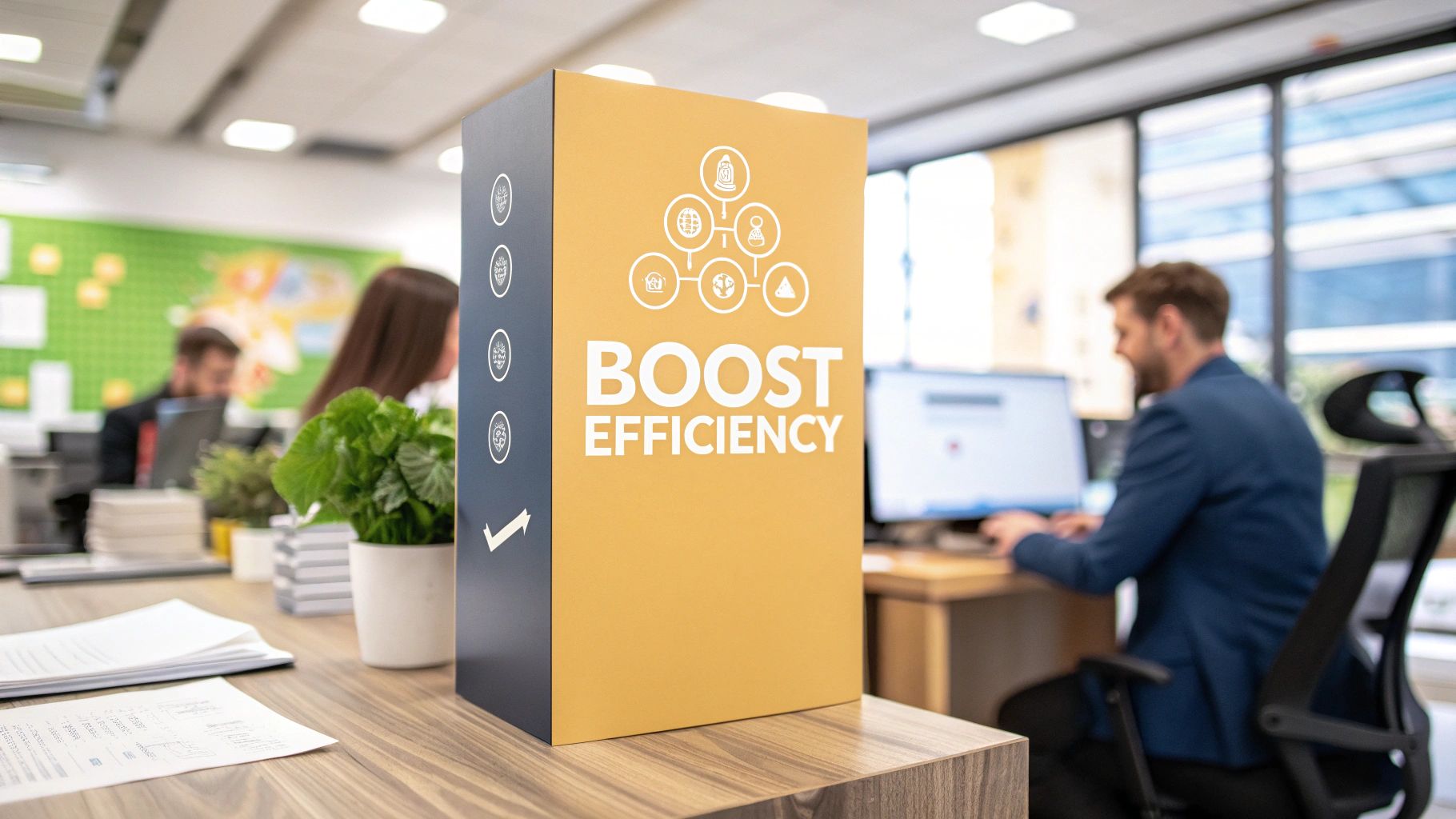In business, manual, repetitive tasks are a significant drain on productivity and resources.In business, manual, repetitive tasks are a significant drain on productivity and resources. From manually onboarding new hires to copying sales lead data between your CRM and email marketing software, these processes consume valuable hours that could be better spent on strategic growth. The core problem is inefficiency, which leads to higher operational costs, increased risk of human error, and slower response times in a competitive market. Workflow automation directly solves this by creating self-operating systems that handle these routine tasks for you, freeing up your team to focus on high-impact work.
This article dives deep into practical workflow automation examples to show you exactly how to reclaim that lost time and supercharge your operations. We’ve compiled a comprehensive list of real-world templates and pre-built solutions from the industry’s leading platforms. Instead of just talking about concepts, we'll provide a strategic breakdown of what makes these automations effective and how you can implement similar systems in your own business.
You will find detailed analyses for each example, complete with screenshots and direct links to the templates themselves. We will explore platforms like Zapier, Make, and Microsoft Power Automate, giving you a clear view of their capabilities. Our goal is to provide a tactical guide, helping you move from idea to implementation quickly. Each entry is designed to offer actionable takeaways, whether you're in marketing, sales, HR, or finance. For a broader understanding of practical applications, you can also explore these additional 7 Workflow Automation Examples to Boost Efficiency. This curated collection will equip you with the insights needed to build a more efficient, scalable, and resilient organization.
1. AI Automation Tools
For businesses aiming to implement a holistic and powerful automation strategy, Up North Media's AI Automation Tools service represents a premier, all-encompassing solution. Instead of offering a single-point software, this service provides a comprehensive, tailored approach that integrates cutting-edge artificial intelligence across core business functions. This makes it an exceptional example of strategic workflow automation, moving beyond simple task management to a full operational overhaul.
What distinguishes this offering is its bespoke nature. Up North Media doesn't provide a one-size-fits-all platform; instead, it leverages deep local market expertise combined with proven AI methodologies to design and implement custom automation strategies. This ensures that the solutions are precisely aligned with a client's specific operational challenges and growth objectives, from automating intricate data entry to deploying advanced predictive analytics for strategic planning.
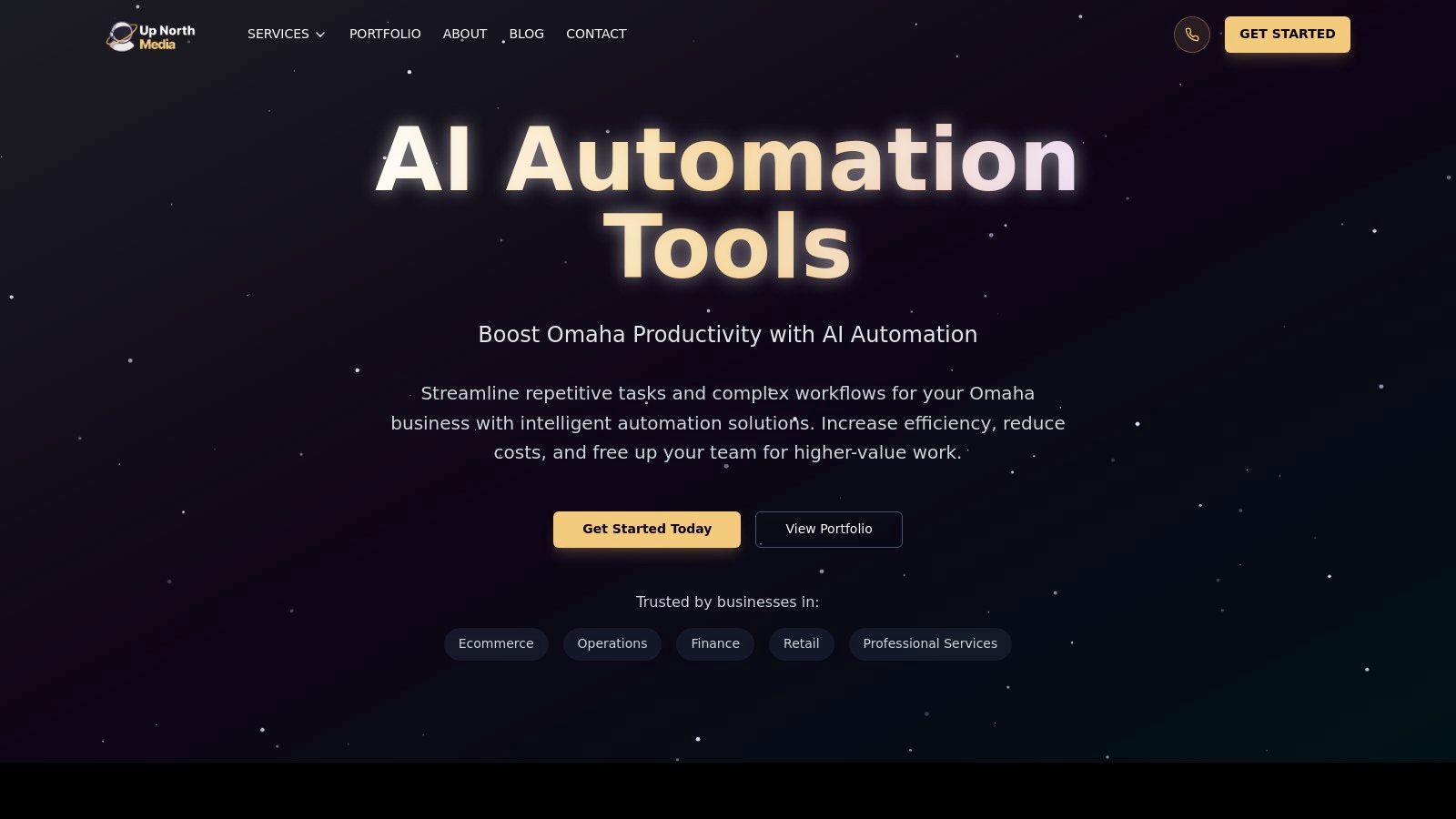
Strategic Breakdown and Use Cases
The power of this service lies in its breadth of application. It provides concrete workflow automation examples across multiple departments, demonstrating a truly integrated approach.
- Marketing & Sales Automation: Beyond standard email sequences, the service builds systems for hyper-targeted campaigns using predictive analytics to identify high-value leads. It also automates social media scheduling and performance tracking, freeing up marketing teams to focus on creative strategy rather than repetitive execution.
- Operations & Data Management: This is a core strength. The service designs workflows for automated data entry, document processing, and validation, which drastically reduces human error and accelerates data-dependent processes. This is crucial for industries like finance, healthcare, and logistics where accuracy is paramount.
- HR & Recruitment: Many of the principles used can be applied to human resources. To see how artificial intelligence powers specific workflows, explore how AI tools are being used for automated candidate screening with AI tools. Automating the initial review of applications allows HR professionals to dedicate more time to qualified candidates.
- Finance & Approvals: The service streamlines complex approval workflows, from expense reports to purchase orders. By setting up rule-based AI systems, approvals can be automatically routed, flagged for review, or processed, ensuring compliance and improving financial velocity.
Why It Stands Out
Up North Media’s service is not just about tools; it's a strategic partnership. Their impressive track record, which includes generating over $10 million in revenue and managing millions of users for clients, validates their methodology. They provide dedicated support from consultation through implementation and offer transparent results tracking, ensuring that the automation strategy delivers a measurable return on investment.
Pros:
- Comprehensive, custom-built AI solutions across multiple business functions.
- Proven success with a strong portfolio demonstrating tangible revenue growth.
- Integrates predictive analytics for deeper, actionable business insights.
- Dedicated client support and transparent performance metrics.
Cons:
- Requires an initial investment for customization and integration.
- The effectiveness is heavily dependent on the quality of your existing data infrastructure.
Actionable Takeaway
For businesses ready to move beyond basic automation and implement a transformative AI-driven strategy, this service is a powerful choice. Start by identifying your most time-consuming, repetitive, and error-prone workflow. A consultation-based service like this can then map that process and build a custom AI solution that not only solves the immediate problem but also scales with your business.
To gain a deeper understanding of how these concepts are put into practice, you can learn more about AI automation for businesses and explore real-world applications.
Website: https://upnorthmedia.co/services/ai-automation-tools
2. Zapier – Template Library
Zapier stands as a titan in the no-code automation space, and its Template Library is the primary reason for its accessibility and widespread adoption. Instead of building complex automations from scratch, users can browse thousands of pre-configured workflows, known as "Zaps." This library offers a vast collection of practical workflow automation examples that can be implemented in minutes, connecting over 6,000 different web applications.
The platform’s core strength lies in its simplicity and sheer breadth of integrations. For a small business in Omaha looking to streamline its sales process, Zapier provides ready-made templates to automatically add new leads from a Facebook Lead Ad directly into a Salesforce or HubSpot CRM, and then send a personalized welcome email via Gmail. This immediate, tangible value makes it an ideal starting point for anyone new to automation.
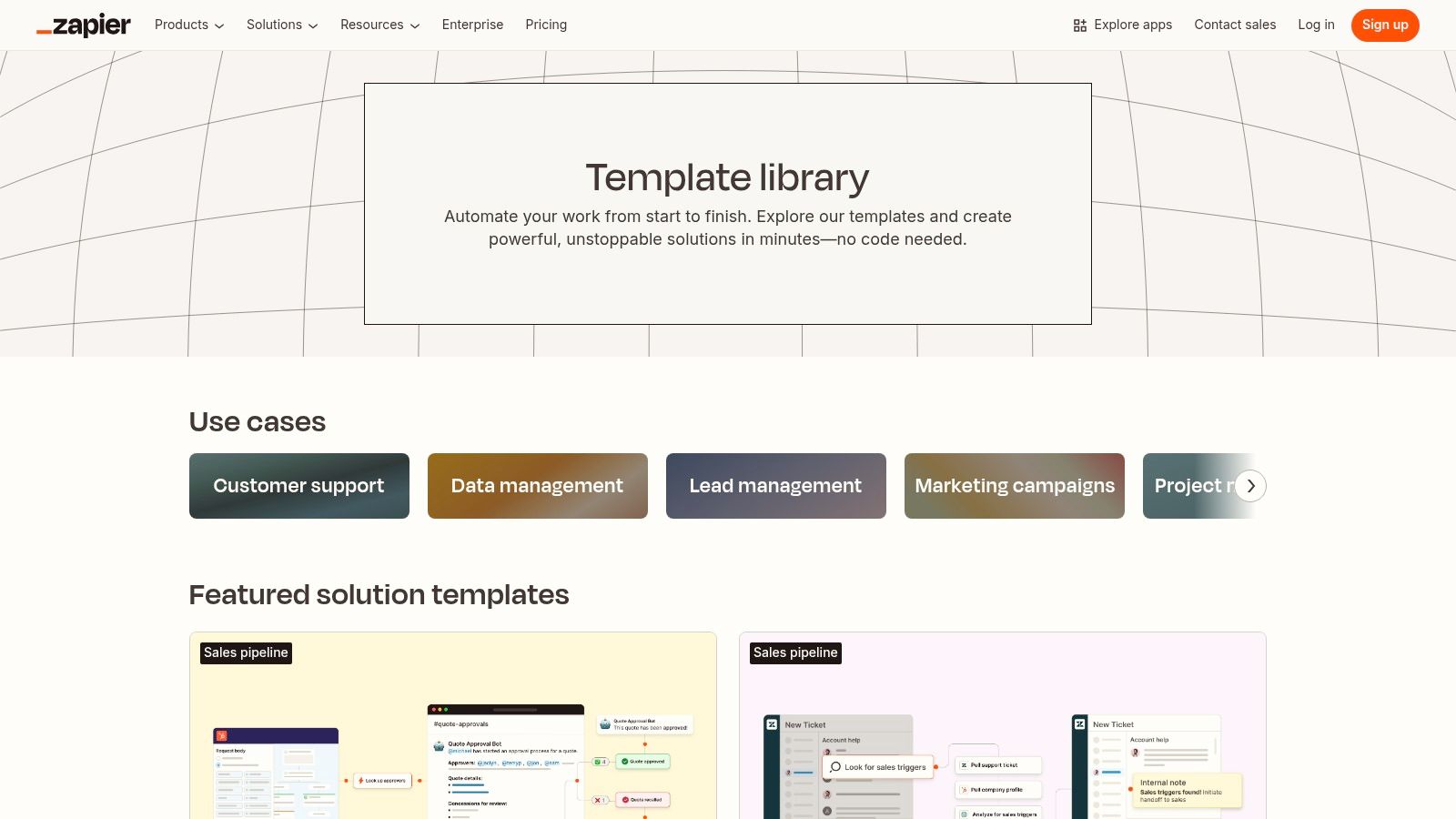
Strategic Analysis & Unique Offerings
What makes the Zapier Template Library unique is its role as both an educational tool and an implementation engine. By browsing templates, users can discover automation possibilities they hadn't considered, such as automatically posting new blog articles to all social media channels or saving email attachments to a specific Google Drive folder. Each template is a blueprint for efficiency.
The user experience is highly intuitive. You can search by the app you want to connect (e.g., "Slack") or the goal you want to achieve (e.g., "lead management"). This problem-oriented approach lowers the barrier to entry significantly.
Strategic Insight: Zapier’s model thrives on community-driven growth. The most popular Zaps are often highlighted, creating a feedback loop where successful automation strategies are surfaced and replicated by a wider audience, democratizing sophisticated workflows.
Actionable Takeaways & Practical Use
For businesses looking to get started, the key is to begin with a small, repetitive task. A great first step is to use the search function to find a template that solves a single, specific pain point.
- Tip 1: Start with the "Popular" or "Trending" templates to see battle-tested workflow automation examples.
- Tip 2: Use a template as a base. Once activated, you can customize it by adding more steps, filters, or conditional logic to perfectly match your internal process.
- Tip 3: Pay close attention to your plan's "Task" limit. Each action a Zap performs counts as a task, so high-volume workflows can become costly.
| Feature | Details |
|---|---|
| Pricing | Freemium model available; paid plans start at ~$19.99/month (billed annually). |
| Best For | SMBs, startups, and marketing/operations teams needing quick, multi-app integrations. |
| Unique Feature | Massive library of pre-built "Zap" templates for instant automation. |
| Customer Support | Primarily email and forum-based for lower tiers; premium support on higher plans. |
Zapier’s Template Library is more than just a feature; it's an extensive catalog of solutions that makes powerful automation accessible to everyone, regardless of technical skill.
Website: https://zapier.com/templates
3. Make (formerly Integromat) – Templates Gallery
Make, formerly known as Integromat, is a powerful automation platform renowned for its visual workflow builder. Its Templates Gallery serves as an excellent entry point into its capabilities, offering a wide array of pre-built "scenarios" that showcase its advanced logic and data manipulation features. These templates provide robust workflow automation examples designed for users who require more than simple linear connections between apps.
The platform's primary strength is its visual, drag-and-drop interface where users can see the flow of data and add complex elements like routers for branching logic or error handlers for resilience. For an Omaha-based logistics company, a Make template could automatically parse incoming shipment emails, extract attachment data, update a master Google Sheet, and route notifications to different Slack channels based on the shipment's origin. This level of granular control makes it a favorite among more technical users and operations specialists.
Strategic Analysis & Unique Offerings
What sets the Make Templates Gallery apart is its emphasis on complex, multi-step processes. While other platforms excel at simple A-to-B connections, Make's templates often demonstrate sophisticated branching, data aggregation, and iteration. This visual approach demystifies complex workflows, allowing users to see exactly how data is transformed at each step.
The gallery is curated by both the Make team and its partners, ensuring a high standard of quality and practical application. Users can search for templates connecting specific apps or solving particular business problems, such as "sync e-commerce orders to accounting software." The guided setup wizards within each template help users configure the scenario for their specific needs without feeling overwhelmed.
Strategic Insight: Make's visual-first philosophy positions it as a bridge between simple no-code tools and custom-coded solutions. Its templates act as educational blueprints, teaching users how to build powerful, non-linear automations that can handle real-world business complexity and exceptions.
Actionable Takeaways & Practical Use
For businesses ready to move beyond basic automation, Make offers a higher ceiling for customization. The key is to start with a template that approximates your desired outcome and then adapt it.
- Tip 1: Don't just activate a template; open it in the scenario editor to understand its structure. Trace the data path to see how modules like "Routers" and "Iterators" work.
- Tip 2: Leverage Make’s powerful data stores. Use a template as a starting point to build workflows that save and retrieve data, creating simple internal databases without extra tools.
- Tip 3: Understand the "Operations" pricing model. Each module that runs in a scenario consumes an operation. Monitor your usage carefully as complex scenarios can consume credits quickly.
| Feature | Details |
|---|---|
| Pricing | Free plan available; paid plans start at ~$9/month (billed annually). |
| Best For | Operations teams, developers, and power users needing detailed control and complex logic. |
| Unique Feature | A visual builder that supports intricate branching, error handling, and data manipulation. |
| Customer Support | 24/7 customer support via online form for paid plans; community forum for free users. |
Make’s Templates Gallery is the ideal launchpad for anyone looking to build more sophisticated, resilient, and custom-tailored automations that can scale with their business logic.
Website: https://www.make.com/en/templates
4. Microsoft Power Automate – Templates (Power Platform)
Microsoft Power Automate solidifies its position as a go-to automation solution for organizations deeply integrated into the Microsoft ecosystem. Its template gallery is a powerful entry point, offering hundreds of pre-configured "flows" designed to connect Microsoft 365, Dynamics 365, SharePoint, and Teams, alongside a wide array of third-party services. These templates provide robust workflow automation examples for everything from simple notifications to complex, multi-stage business processes.
The platform's primary advantage is its native integration within the Microsoft environment. For an Omaha-based company that runs on SharePoint for document management and Teams for communication, Power Automate offers seamless, ready-to-use templates. For example, a flow can automatically save email attachments from Outlook into a specific SharePoint folder and then post a notification in a Teams channel, all without writing a single line of code. This deep-rooted connectivity makes it an indispensable tool for leveraging existing Microsoft investments.
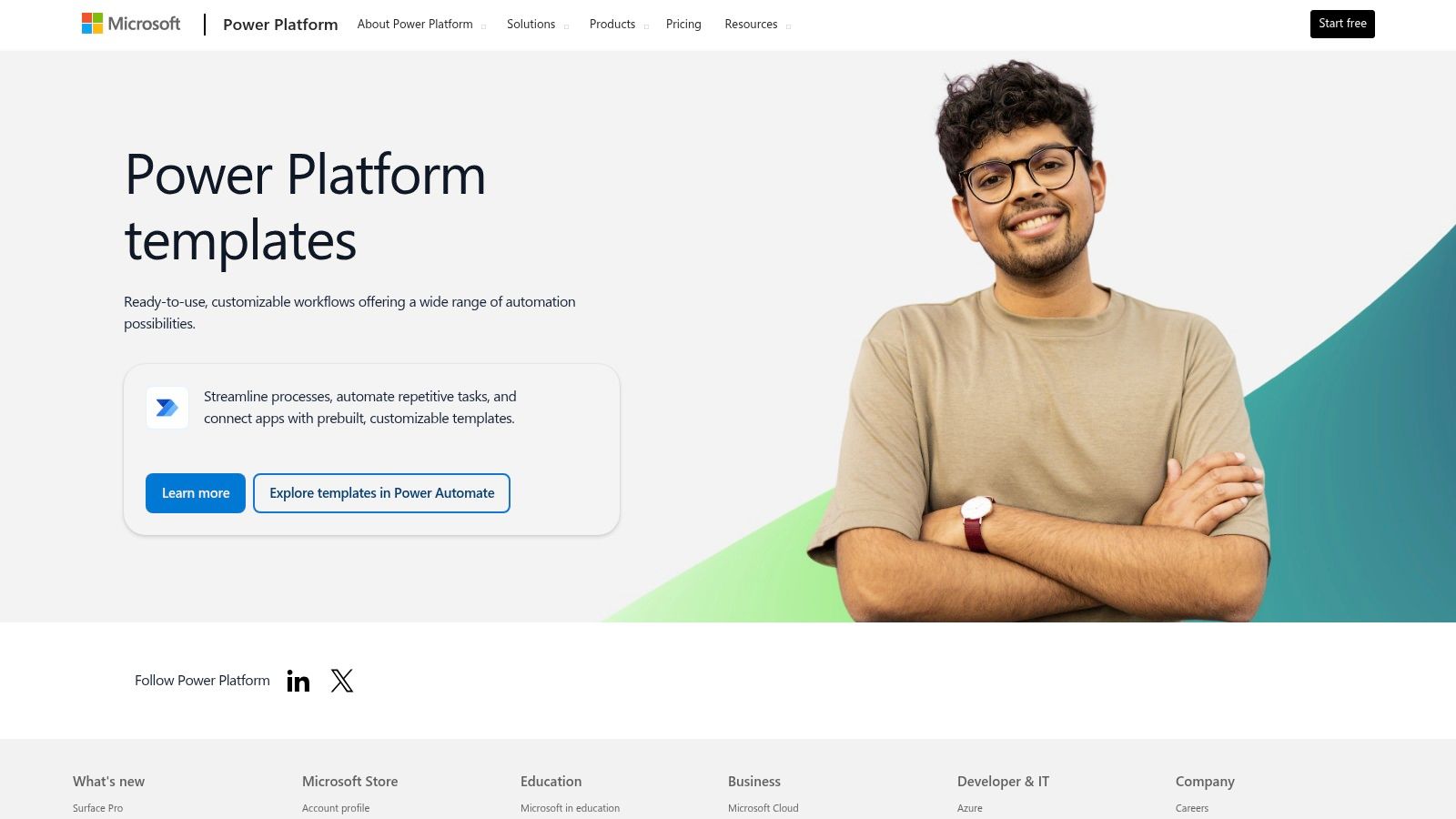
Strategic Analysis & Unique Offerings
What sets Power Automate's template gallery apart is its focus on enterprise-grade governance and scalability within a familiar Microsoft interface. While other platforms excel at connecting external apps, Power Automate shines at enhancing internal processes already managed by Microsoft software. The templates serve as foundational blueprints that IT departments and business users can adapt, ensuring compliance and control.
The user experience feels natural for anyone accustomed to Microsoft 365. Templates are categorized by service (e.g., "SharePoint," "Outlook") or function (e.g., "Data Collection," "Notifications"), making it easy to find relevant solutions. As one of the premier business process automation tools, its library also includes templates for more advanced scenarios, such as robotic process automation (RPA) for interacting with legacy systems.
Strategic Insight: Microsoft's strategy with Power Automate is to create a "low-code" bridge between its core business applications. The template gallery encourages citizen developers within an organization to build and share automations, fostering a culture of process improvement while keeping everything under a unified, manageable IT umbrella.
Actionable Takeaways & Practical Use
For businesses committed to the Microsoft stack, the best approach is to identify a high-volume, manual task involving two or more Microsoft products. The template gallery is the perfect place to find an immediate solution.
- Tip 1: Use the search bar to find templates connecting the specific Microsoft apps you use daily, such as "Outlook to Planner" or "Forms to SharePoint."
- Tip 2: Explore templates that include "Approvals." This is a powerful, built-in feature for creating workflows that require managerial sign-off, such as expense reports or document reviews.
- Tip 3: Be mindful of the licensing model. While many basic connectors are standard, premium connectors and RPA capabilities often require a higher-tier plan or per-user/per-flow licensing.
| Feature | Details |
|---|---|
| Pricing | Limited free version with Microsoft 365; paid plans start at ~$15/user/month. |
| Best For | Enterprises and SMBs heavily invested in the Microsoft 365 and Dynamics 365 ecosystem. |
| Unique Feature | Deep, native integration with Microsoft products like SharePoint, Teams, and Dataverse. |
| Customer Support | Extensive documentation and community forums; direct support tied to Microsoft 365 plans. |
Microsoft Power Automate's templates offer a fast track to automating and optimizing internal business operations, making it an essential platform for any Microsoft-centric organization.
Website: https://www.microsoft.com/en-us/power-platform/templates
5. IFTTT – Applets (Explore)
IFTTT, which stands for "If This Then That," pioneered simple, accessible automation for the everyday user. Its Explore section is a massive repository of pre-built connections, known as "Applets," that link a wide range of services, from social media platforms to smart home devices. These Applets serve as excellent introductory workflow automation examples, allowing users to activate powerful connections with a single click.
The platform's strength is its consumer-friendly approach and deep integration with the Internet of Things (IoT). For a small business owner in Omaha, this could mean automatically turning on the office lights when they arrive or getting an instant notification on their phone whenever their business is mentioned on Reddit. IFTTT excels at these types of lightweight, personal productivity and environmental automations that simplify daily routines.
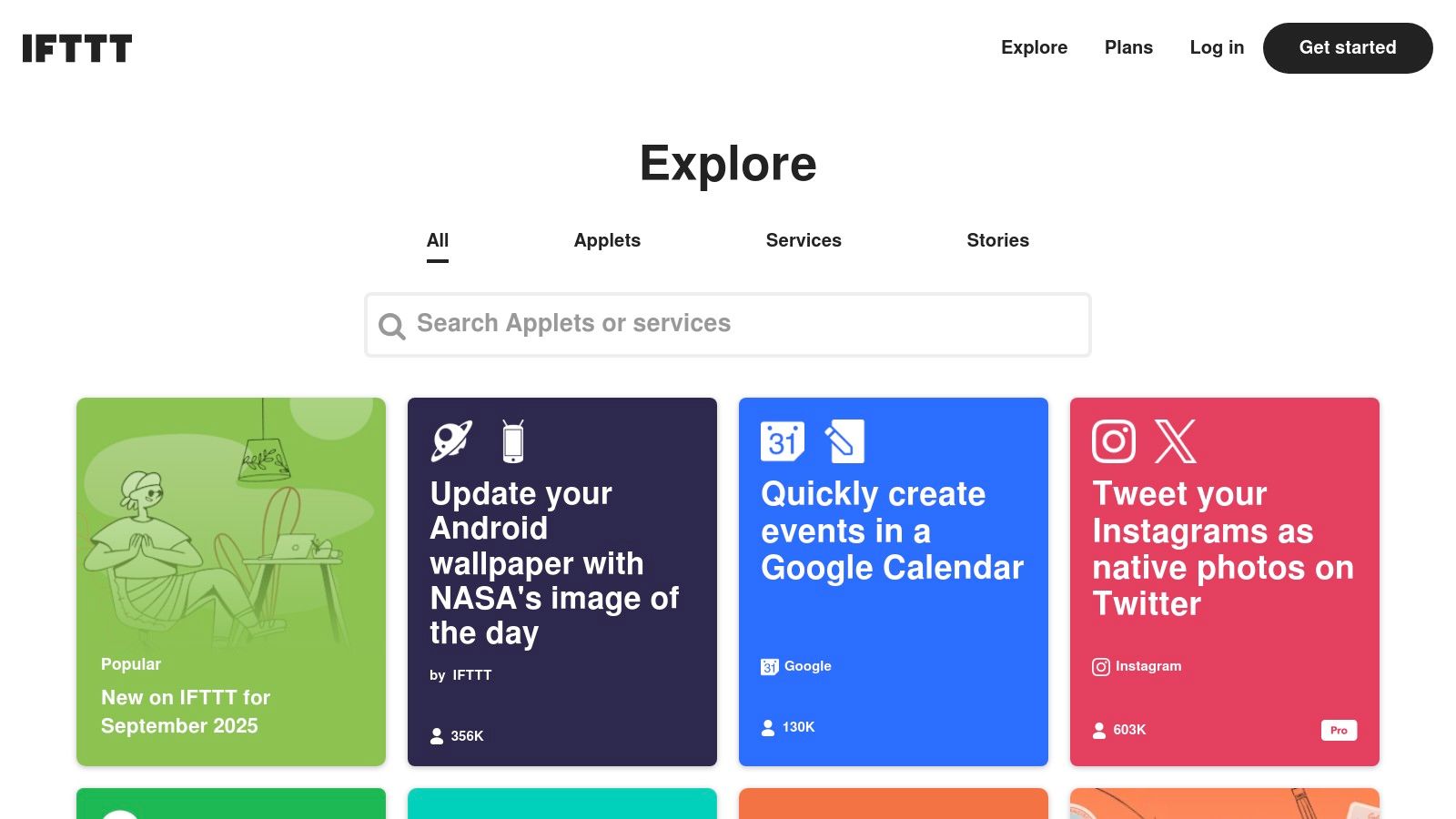
Strategic Analysis & Unique Offerings
What sets IFTTT's Explore page apart is its focus on discovery and simplicity for both personal and professional tasks. Unlike more business-centric platforms, IFTTT bridges the gap between smart devices, mobile apps, and work tools. The Applets are presented in a visually engaging, card-based layout, encouraging users to browse and discover automation ideas they might not have otherwise considered.
The user experience is designed for immediate action. You can search by service (e.g., "Google Calendar") or browse collections curated by the IFTTT team, such as "Work from home essentials" or "Automations for Twitter." This approach makes it incredibly easy to find a solution to a specific problem without needing any technical knowledge.
Strategic Insight: IFTTT's power lies in its ubiquity and simplicity. By focusing on single-trigger, single-action Applets in its free tier, it has become the default automation tool for the IoT and consumer app ecosystem, creating a vast network effect.
Actionable Takeaways & Practical Use
For businesses or individuals new to automation, the key is to think about the digital and physical tools you use every day. IFTTT is perfect for connecting disparate parts of your life and work environment.
- Tip 1: Use the Explore search to connect a physical device to a digital service. For example, automatically log office entry and exit times from a smart lock to a Google Sheet.
- Tip 2: Leverage IFTTT for simple content syndication. Create an Applet to automatically share your new WordPress posts to a specific Slack channel or add new YouTube videos to a Pocket list.
- Tip 3: Upgrade to Pro or Pro+ to unlock multi-step Applets, queries, and filter code, which allows for more complex, business-oriented workflows that rival other platforms.
| Feature | Details |
|---|---|
| Pricing | Free tier available; Pro plan starts at ~$2.50/month (billed annually). |
| Best For | Individuals, freelancers, and small teams seeking personal productivity and smart device automations. |
| Unique Feature | Extensive integrations with IoT/smart home devices and mobile services. |
| Customer Support | Primarily through a help center and community forums; ticketed support for Pro+ users. |
IFTTT's Applet library is an inspirational starting point, proving that valuable automation doesn't have to be complex or confined to a business setting.
Website: https://ifttt.com/explore
6. n8n – Community Workflow Templates
n8n emerges as a powerful, open-source alternative in the automation landscape, particularly appealing to a more technical audience. Its Community Workflow Templates gallery is a testament to its flexibility, offering thousands of user-submitted automations that range from simple data synchronization to complex AI-driven processes. These templates serve as excellent workflow automation examples for developers, IT professionals, and businesses that prefer self-hosting and full control over their data and infrastructure.
The platform's strength is its open and extensible nature. For a tech startup in Omaha looking to integrate a custom internal tool with a large language model like OpenAI's GPT-4, n8n provides the nodes and the community-built frameworks to make it happen. Users can find and import workflows directly in JSON format, allowing for rapid deployment and customization of sophisticated, multi-step automations that might be difficult or impossible on more restrictive platforms.
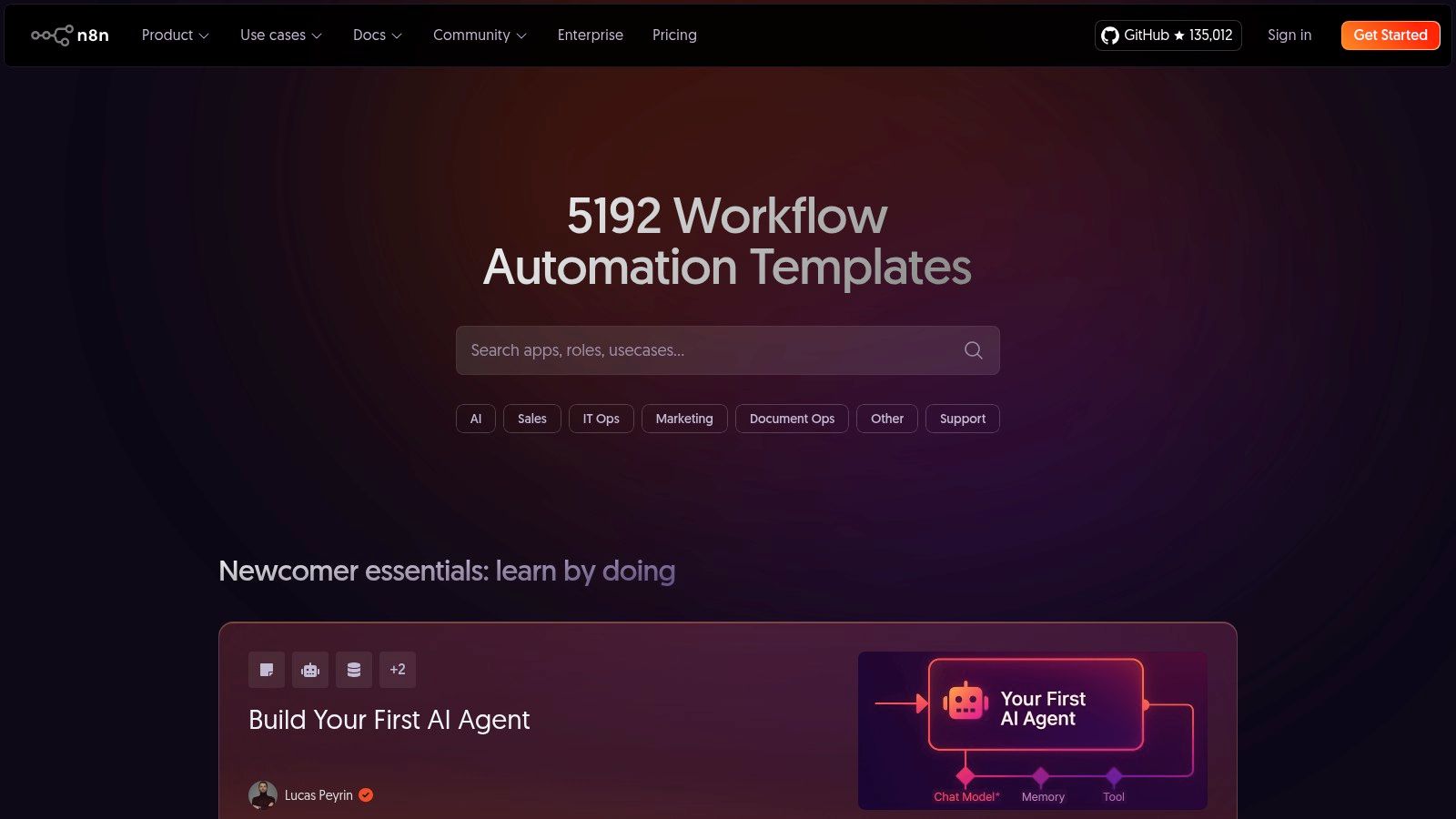
Strategic Analysis & Unique Offerings
What distinguishes n8n's template gallery is its direct connection to an active, innovative developer community. Since the platform is open-source, the templates often showcase cutting-edge use cases, especially in areas like AI, data scraping, and custom API integrations. You can find workflows for automating code deployments, managing server logs, or even creating AI-powered content generation pipelines.
The user experience is geared toward those comfortable with a node-based visual editor. Each template can be inspected, forked, and modified with granular control. This transparency is a key differentiator, allowing users to not just use a workflow but to truly understand and adapt its logic to their specific needs without vendor lock-in.
Strategic Insight: n8n leverages the open-source ethos to its advantage. The community's constant innovation feeds the template library, creating a repository of advanced and highly specific solutions that a single company would struggle to develop, ensuring the platform remains at the forefront of automation technology.
Actionable Takeaways & Practical Use
For technically-inclined teams, the n8n gallery is a goldmine for advanced automation blueprints. The best approach is to search for a specific tool or problem and use an existing template as a starting point for a more complex build.
- Tip 1: Filter workflows by the specific apps or nodes you use to find relevant, pre-built solutions for your tech stack.
- Tip 2: Always review the nodes and code within a community template before running it with sensitive data, as quality can vary.
- Tip 3: Contribute back to the community. If you build a useful workflow, share it to help others and receive feedback for improvements.
| Feature | Details |
|---|---|
| Pricing | Free, self-hosted option available; Cloud plans start at ~$20/month. |
| Best For | Developers, IT teams, and tech-savvy businesses wanting full control and customizability. |
| Unique Feature | Open-source model with a community-driven library of advanced, shareable workflows. |
| Customer Support | Primarily community forums for the self-hosted version; dedicated support on paid Cloud plans. |
n8n’s Community Workflow Templates offer a look into the future of extensible automation, providing a platform where complex and custom processes can be built and shared freely.
Website: https://n8n.io/workflows
7. Workato – Community Library (Recipes)
Workato positions itself as an enterprise-grade automation platform, and its Community Library is a testament to this focus. It offers thousands of pre-built, clonable workflows, known as "Recipes," designed for complex business processes. Unlike entry-level tools, these recipes often tackle sophisticated use cases in finance, IT operations, and data integration, providing powerful workflow automation examples for mid-market and enterprise users.
The platform excels at orchestrating automations that require robust governance, security, and scalability. For an Omaha-based manufacturing firm, a Workato recipe could automate the entire procure-to-pay cycle, connecting SAP, Salesforce, and Coupa to ensure data consistency and compliance. This enterprise-centric approach makes it a go-to for organizations with mission-critical operational needs.
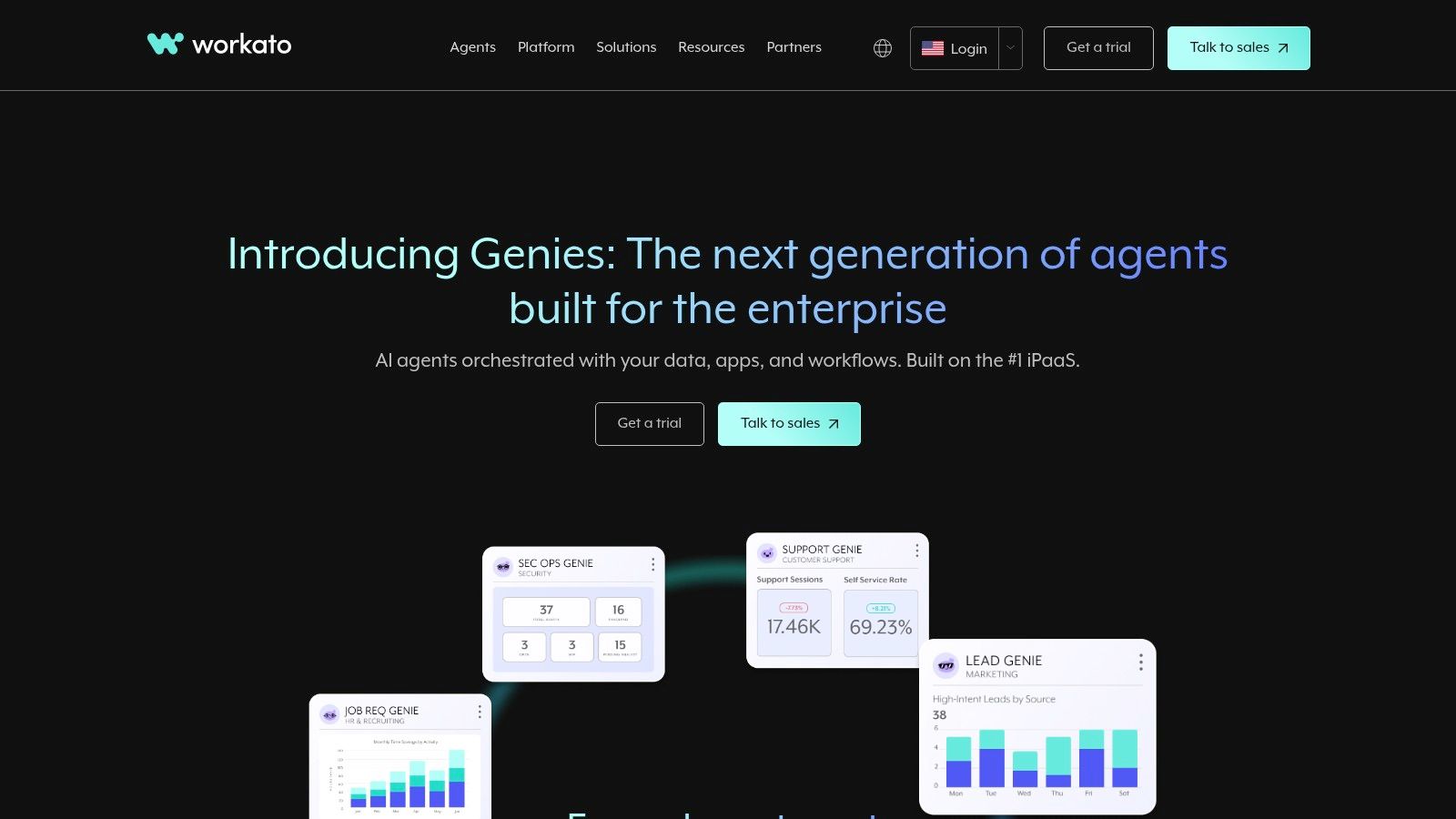
Strategic Analysis & Unique Offerings
What distinguishes the Workato Community Library is its focus on production-ready, high-volume workflows. The recipes are not just simple app-to-app connections; they are often comprehensive solutions that incorporate conditional logic, error handling, and data governance. This allows teams to deploy automations with confidence in regulated or complex environments.
The library is searchable by app, business function (e.g., "employee onboarding"), or specific use case. Each recipe comes with a detailed breakdown of its steps and the business problem it solves, serving as both a practical tool and an educational resource for advanced automation strategies. Exploring these diverse offerings can help businesses understand how to leverage some of the most advanced AI automation tools available.
Strategic Insight: Workato’s library is built for collaboration and reuse. It allows teams to create, share, and manage recipes internally, fostering a culture of automation at scale. This emphasis on governance makes it ideal for companies that need to maintain strict control over their automated processes.
Actionable Takeaways & Practical Use
For organizations considering Workato, the key is to identify a core business process that involves multiple departments and legacy systems. The Community Library is the best place to find a recipe that can serve as a proven foundation for that process.
- Tip 1: Use the filter function to search for recipes specific to your core applications (like NetSuite, Salesforce, or ServiceNow) to see how others are solving similar problems.
- Tip 2: Clone a community recipe and use it in a sandbox environment. This allows you to test and customize the workflow without impacting live operations.
- Tip 3: Analyze the "Jobs" and "Connections" sections of a recipe to understand its data flow and dependencies before deploying it in a production environment.
| Feature | Details |
|---|---|
| Pricing | Quote-based; requires engagement with the sales team for a custom plan. |
| Best For | Mid-market to enterprise companies, IT departments, and finance/ops teams. |
| Unique Feature | Enterprise-grade "Recipes" with advanced logic, governance, and security controls. |
| Customer Support | Dedicated support managers, implementation services, and extensive documentation. |
Workato’s Community Library is an accelerator for digital transformation, providing the blueprints for building resilient, scalable, and secure automations that drive core business functions.
Website: https://www.workato.com
Workflow Automation Tools Comparison Overview
| Solution | 🔄 Implementation Complexity | ⚡ Resource Requirements | ⭐ Expected Outcomes | 💡 Ideal Use Cases | 📊 Key Advantages |
|---|---|---|---|---|---|
| AI Automation Tools (Up North Media) | Moderate to High – requires customization and integration | Medium to High – tailored solutions and data quality dependent | High – boosts efficiency, accuracy, and actionable AI insights | Businesses needing bespoke automation aligned with specific goals | Custom AI-driven automation, predictive analytics, personalized support |
| Zapier – Template Library | Low – ready-to-use templates, quick setup | Low to Medium – cost scales with usage | Medium – fast automation deployment | Users seeking quick no-code automation across many apps | Massive template gallery, broad app coverage, fast activation |
| Make (formerly Integromat) | Medium to High – visual builder with complex workflow support | Medium – visual tools for technical users | Medium to High – fine control over workflows | Technical users wanting detailed automation control | Strong branching/logic, good value for complex workflows |
| Microsoft Power Automate | Medium to High – enterprise-focused, licensing complexity | Medium to High – licensing varies by features | High – deep integration in Microsoft ecosystems | Microsoft-centric organizations needing enterprise governance | Deep Microsoft 365 integration, enterprise governance, large community |
| IFTTT – Applets (Explore) | Very Low – one-click automations, minimal setup | Low – basic to moderate on Pro tiers | Low to Medium – suitable for lightweight tasks | Personal/small team use, smart home, productivity | Extremely easy onboarding, wide range of apps and devices |
| n8n – Community Workflow Templates | Medium to High – technical setup, open-source flexibility | Medium – self-hosted or cloud, technical skills needed | Medium to High – advanced and customizable workflows | Technical users/teams wanting open-source, extensible automations | Open-source, no vendor lock-in, advanced nodes, community-driven |
| Workato – Community Library | High – enterprise-grade, steeper learning curve | High – requires sales engagement and governance | Very High – production-ready, scalable automation | Mid-market/enterprise needing robust governance and scaling | Enterprise-grade workflows, strong governance, detailed guidance |
Final Thoughts
The journey through these diverse workflow automation examples showcases a fundamental shift in how modern businesses operate. From streamlining marketing campaigns with AI-driven content creation to automating complex financial reporting, the potential to reclaim time and redirect resources toward strategic growth is immense. We've seen how platforms like Zapier and Make offer accessible, template-driven solutions for everyday tasks, while tools like n8n and Workato provide robust, scalable frameworks for more complex, enterprise-level integrations.
The common thread woven through every successful implementation is a clear, strategic approach. It’s not just about connecting App A to App B; it’s about understanding the underlying business process, identifying the friction points, and designing an automated solution that directly addresses those challenges. The most effective automations are born from a deep understanding of a team's day-to-day operational pain points.
Key Takeaways from Our Exploration
Reflecting on the examples provided, several core principles emerge as critical for success. These are the strategic pillars you should build your automation initiatives upon.
- Start Small, Scale Smart: Don't try to automate your entire company overnight. Begin with a single, high-impact, low-complexity workflow. The lead nurturing sequence or the automated social media posting examples are perfect starting points. A quick win builds momentum and provides valuable learning experiences.
- Process First, Technology Second: The most powerful tool is ineffective if applied to a broken process. Before you even log into Zapier or Power Automate, map out your existing workflow. Identify redundancies, bottlenecks, and manual data entry points. A clear process map is your blueprint for a successful automation.
- Embrace the Template Libraries: The template libraries and community recipes offered by platforms like Make, IFTTT, and Workato are invaluable resources. They are not just shortcuts; they are proven workflow automation examples that you can deconstruct, learn from, and adapt to your specific needs.
Your Actionable Path Forward
Transforming these insights into action is the next critical step. To get started, focus your efforts on a structured approach that ensures you choose the right path for your organization's unique needs.
- Conduct a Workflow Audit: Gather your team and identify the top three most time-consuming, repetitive tasks in your department. Is it manually creating invoices? Compiling weekly reports? Onboarding new employees? Quantify the time spent on these tasks to identify the highest-value automation target.
- Choose the Right Tool for the Job: Your choice of platform is crucial. For simple, linear tasks connecting two or three popular cloud apps, Zapier or IFTTT are excellent. For more complex, multi-step workflows that require conditional logic and data manipulation, Make or n8n offer greater flexibility. For businesses heavily invested in the Microsoft ecosystem, Power Automate is the natural choice.
- Build Your First Automation: Using your workflow audit as a guide, select one process and build it out using a free or trial plan. Document every step, test it thoroughly with sample data, and monitor the results closely. This initial project will be your proof of concept.
The power of workflow automation lies in its ability to compound. Each automated task frees up time and mental energy, allowing your team to focus on innovation, customer relationships, and strategic initiatives that truly drive the business forward. The examples we’ve explored are not just case studies; they are a clear roadmap to a more efficient, productive, and scalable future for your business.
Feeling inspired by these workflow automation examples but need a strategic partner to design and implement custom solutions? Up North Media specializes in developing bespoke AI integrations and automation systems that streamline operations for Omaha businesses. Visit Up North Media to learn how we can build the powerful, scalable automations your business needs to thrive.
